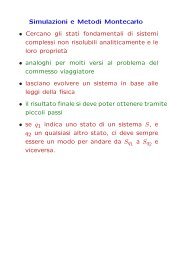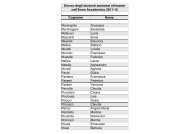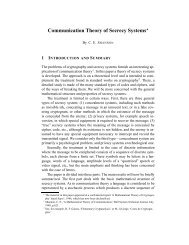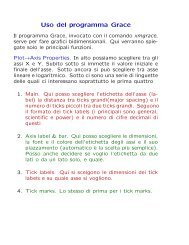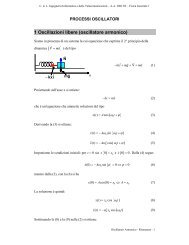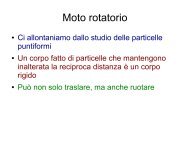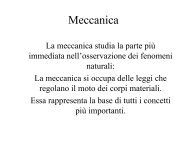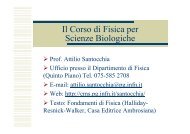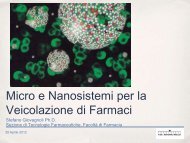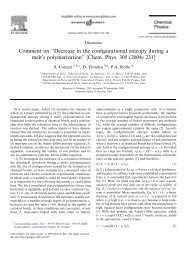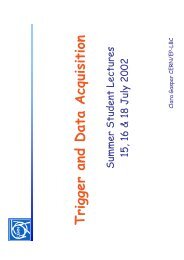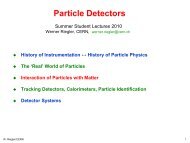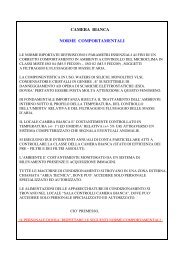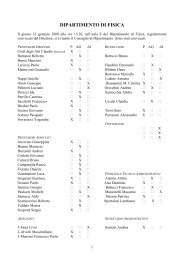Two crossover regions in the dynamics of glass forming ... - Fisica
Two crossover regions in the dynamics of glass forming ... - Fisica
Two crossover regions in the dynamics of glass forming ... - Fisica
You also want an ePaper? Increase the reach of your titles
YUMPU automatically turns print PDFs into web optimized ePapers that Google loves.
J. Chem. Phys., Vol. 117, No. 5, 1 August 2002 <strong>Two</strong> <strong>crossover</strong> <strong>regions</strong> <strong>in</strong> <strong>the</strong> <strong>dynamics</strong> <strong>of</strong> epoxy res<strong>in</strong>s<br />
FIG. 2. a Real and b imag<strong>in</strong>ary part <strong>of</strong> *() for DGEBA selected<br />
data at several temperatures 353, 343, 333, 323, 313, 303, 298, 293, 288,<br />
283, 278, 273, 268, 263, 259, 256 K above T g , <strong>in</strong> <strong>the</strong> range 10 2 –2<br />
10 10 Hz. The solid l<strong>in</strong>es represent a fit with two HN functions. In <strong>the</strong><br />
<strong>in</strong>set: dielectric loss at some temperatures 223, 203, 183, 163, 143 K<br />
below T g , show<strong>in</strong>g <strong>the</strong> process at higher frequencies and <strong>the</strong> process at<br />
lower frequencies. The best fit with a symmetrical Cole–Cole function plus<br />
a HN function is shown by solid l<strong>in</strong>es.<br />
chased. PPGE is an epoxy res<strong>in</strong> with average molecular<br />
weight <strong>of</strong> 345 g/mol. It was obta<strong>in</strong>ed from Aldrich Chemicals<br />
and was measured as received. The chemical formula <strong>of</strong><br />
this material is given <strong>in</strong> Fig. 2a. The conventional <strong>glass</strong><br />
transition temperatures are T g2551 K for DGEBA and<br />
T g2581 K for PPGE. The T g values were obta<strong>in</strong>ed by an<br />
equal-area construction from differential scann<strong>in</strong>g calorimetry<br />
DSC curves, acquired by a Perk<strong>in</strong>-Elmer DSC 7 apparatus,<br />
at a heat<strong>in</strong>g rate <strong>of</strong> dT/dt10 K/m<strong>in</strong>.<br />
B. Measurements<br />
1. Dielectric spectroscopy<br />
Due to <strong>the</strong> strong permanent dipoles orig<strong>in</strong>at<strong>in</strong>g from <strong>the</strong><br />
presence <strong>of</strong> epoxy groups 2.1 D per epoxy group, both<br />
DGEBA and PPGE are particularly suitable for a dielectric<br />
<strong>in</strong>vestigation. Measurements <strong>of</strong> <strong>the</strong> dielectric constant<br />
*(,T)i <strong>in</strong> PPGE were carried out by means <strong>of</strong><br />
an Alpha Novocontrol dielectric analyzer Pisa & Ma<strong>in</strong>z<br />
and an impedance analyzer HP4194A Pisa <strong>in</strong> <strong>the</strong> frequency<br />
range from 10 2 to 10 7 Hz. A network analyzer HP8753A<br />
Perugia was used to cover <strong>the</strong> frequency range from 10 7 to<br />
310 9 Hz. Iso<strong>the</strong>rmal frequency scans were performed <strong>in</strong><br />
<strong>the</strong> temperature <strong>in</strong>terval from 357.8 to 133.2 K, dur<strong>in</strong>g several<br />
series <strong>of</strong> measurements.<br />
The dielectric constant <strong>of</strong> DGEBA was measured <strong>in</strong> <strong>the</strong><br />
frequency range from 10 1 to 10 6 Hz by a Novocontrol BDS<br />
4000 based on a Solartron FRA 1260 Halle. The temperature<br />
<strong>in</strong>terval was from 123.2 to 293.2 K, i.e., from far below<br />
to well above <strong>the</strong> <strong>glass</strong> transition temperature, <strong>in</strong> steps <strong>of</strong> 5<br />
degrees. The results are compared with previously published<br />
dielectric data <strong>in</strong> <strong>the</strong> frequency range from 10 2 to 2<br />
10 10 Hz Ref. 8 and data at lower frequencies down to<br />
10 2 Hz Ref. 29. Altoge<strong>the</strong>r we present dielectric results<br />
for DGEBA cover<strong>in</strong>g 12 decades <strong>of</strong> frequency, obta<strong>in</strong>ed <strong>in</strong><br />
<strong>the</strong> temperature range from 123.2 to 353.2 K.<br />
The real and imag<strong>in</strong>ary parts <strong>of</strong> <strong>the</strong> dielectric constant,<br />
() and (), <strong>of</strong> our samples are displayed <strong>in</strong> Figs. 1<br />
and 2 at several temperatures. The iso<strong>the</strong>rmal data for <strong>the</strong><br />
dielectric constant were analyzed <strong>in</strong> terms <strong>of</strong> l<strong>in</strong>ear superposition<br />
<strong>of</strong> relaxation and conductivity contributions additive<br />
ansatz, with each relaxation process described by a<br />
Havriliak–Negami HN function:<br />
* k<br />
k<br />
1i HNk 1 k k<br />
i<br />
. 1<br />
0<br />
In Eq. 1 <strong>the</strong> <strong>in</strong>dex k runs over <strong>the</strong> relaxation processes and<br />
<strong>the</strong> conductivity effect is taken <strong>in</strong>to account by <strong>the</strong> term<br />
i/ 0 0 is <strong>the</strong> dielectric permittivity <strong>of</strong> vacuum. is<br />
<strong>the</strong> high-frequency limit <strong>of</strong> outside <strong>the</strong> dispersion zone,<br />
and k is <strong>the</strong> dielectric strength <strong>of</strong> each process. The fit<br />
with this phenomenological function allows us to extract<br />
characteristic parameters for <strong>the</strong> different relaxation peaks,<br />
i.e., <strong>the</strong> frequency <strong>of</strong> maximum loss and <strong>the</strong> peak shape. The<br />
frequency <strong>of</strong> maximum , f max , can be analytically calculated<br />
from <strong>the</strong> HN fitt<strong>in</strong>g parameters by<br />
1/1<br />
1<br />
f max2 HN 1 s<strong>in</strong><br />
21 s<strong>in</strong> 1/1<br />
2437<br />
1<br />
21 . 2<br />
From this quantity a characteristic relaxation time max<br />
(2f max) 1 , can be easily obta<strong>in</strong>ed, usually preferred to<br />
HN s<strong>in</strong>ce it is a model-<strong>in</strong>dependent parameter. Concern<strong>in</strong>g<br />
<strong>the</strong> shape <strong>of</strong> <strong>the</strong> dielectric peak, <strong>the</strong> HN function gives <strong>the</strong><br />
asymptotic behavior <strong>of</strong> () <strong>in</strong> <strong>the</strong> low- and highfrequency<br />
limits as power laws, m and n respectively,<br />
whose exponents are simply expressed <strong>in</strong> terms <strong>of</strong><br />
<strong>the</strong> HN shape parameters and through <strong>the</strong> relations m<br />
(1) and n(1).<br />
The real and <strong>the</strong> imag<strong>in</strong>ary parts <strong>of</strong> *() have been<br />
fitted simultaneously by us<strong>in</strong>g <strong>the</strong> nonl<strong>in</strong>ear least-squares<br />
Levenberg–Marquard rout<strong>in</strong>e. The uncerta<strong>in</strong>ties <strong>of</strong> <strong>the</strong> fitt<strong>in</strong>g<br />
parameters have been estimated by means <strong>of</strong> a Monte Carlo<br />
procedure. In particular, start<strong>in</strong>g from each experimental<br />
spectrum 100 ‘‘artificial’’ data sets have been produced by<br />
means <strong>of</strong> <strong>the</strong> bootstrap Monte Carlo method, 30 replac<strong>in</strong>g a<br />
random fraction <strong>of</strong> orig<strong>in</strong>al po<strong>in</strong>ts by duplicated orig<strong>in</strong>al<br />
po<strong>in</strong>ts. Each data set has been fitted by means <strong>of</strong> <strong>the</strong><br />
Levenberg–Marquardt rout<strong>in</strong>e, giv<strong>in</strong>g a distribution <strong>of</strong> fitt<strong>in</strong>g<br />
parameters. An estimate <strong>of</strong> <strong>the</strong> error <strong>of</strong> each parameter has<br />
been obta<strong>in</strong>ed by <strong>the</strong> standard deviation <strong>of</strong> <strong>the</strong> probability<br />
distribution <strong>of</strong> <strong>the</strong> fitt<strong>in</strong>g parameters. F<strong>in</strong>ally, <strong>the</strong> errors <strong>of</strong> <strong>the</strong><br />
HN fitt<strong>in</strong>g parameters have been used to estimate <strong>the</strong> error <strong>of</strong><br />
<strong>the</strong> relaxation time max .<br />
Downloaded 14 Nov 2002 to 194.95.63.241. Redistribution subject to AIP license or copyright, see http://ojps.aip.org/jcpo/jcpcr.jsp



